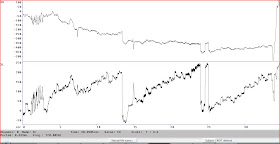This is a
short report on the effect of using an optimised computer screen on the reading
performance of an FE student who has had major problems all the way through his
education.
Can you spot
what might have been the problem?
The first
graph shows the student ‘s eye movements reading on a default computer screen.
To read the
83 words/493 characters his eyes had to stop 122 times. He was processing
around 4 characters per fixation.
The second
graph shows his eye movements when reading from an optimised computer screen.
To read 88
words/ 515 characters his eyes had to stop only 38 times. He was processing
over 13 characters per fixation.
His eyes
showed much greater symmetry of movement, not perfect, but we do not yet really
know what is ‘perfect’.
His reading
speed had gone from 178 words per minute to 447 words per minute.
We do not
know for certain yet how this will affect his concentration, but his self confidence
took a boost.
The question
I ask is this.
Was his
Phonological processing speed being controlled by the visual components of the
task on the default background?
Or was the
visual processing speed being controlled
by the phonological processing speed?
Optimum Settings
|
||
Red
|
Green
|
Blue
|
255
|
172
|
255
|
There was an
improvement in Oral Reading Fluency of
44%. But the change in prosody, which
cannot be quantified was absolutely immense.
There was no evidence of any focussing issues with his eyes.
I suppose this sort of anecdotal data can just be ignored. But what if robust psychophysical data is published?


No comments:
Post a Comment